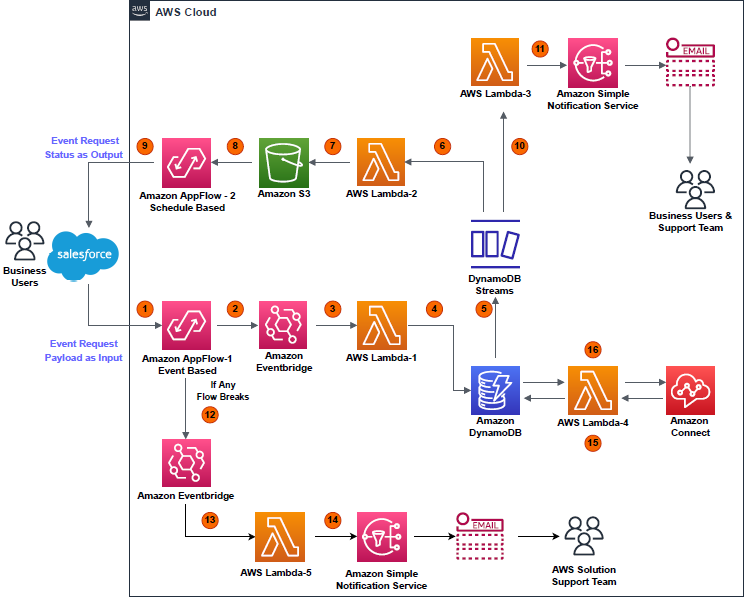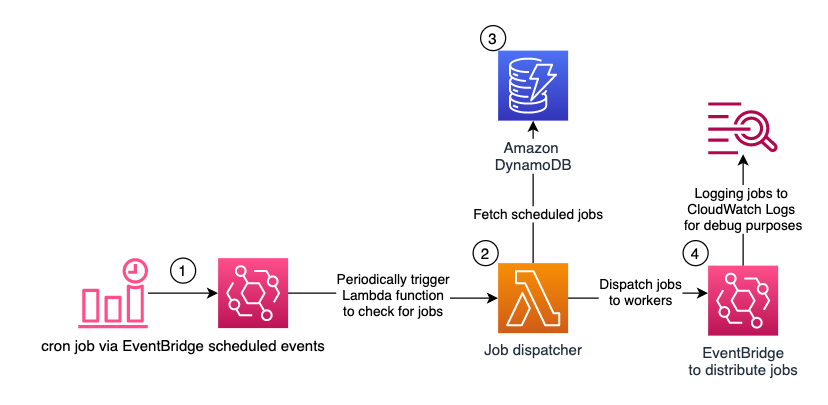AWS Architecture Blog
Category: Amazon EventBridge
Integrating Salesforce with AWS DynamoDB using Amazon AppFlow bi-directionally
In this blog post, we demonstrate how to integrate Salesforce Lightning with Amazon DynamoDB by using Amazon AppFlow and Amazon EventBridge services bi-directionally. This is an event-driven, serverless-based microservice, allowing Salesforce users to update configuration data stored in DynamoDB tables without giving AWS account access from AWS Command Line Interface or AWS Management Console. This […]
Extending your SaaS platform with AWS Lambda
Software as a service (SaaS) providers continuously add new features and capabilities to their products to meet their growing customer needs. As enterprises adopt SaaS to reduce the total cost of ownership and focus on business priorities, they expect SaaS providers to enable customization capabilities. Many SaaS providers allow their customers (tenants) to provide customer-specific […]
How to track AWS account metadata within your AWS Organizations
United Services Automobile Association (USAA) is a San Antonio-based insurance, financial services, banking, and FinTech company supporting millions of military members and their families. USAA has partnered with Amazon Web Services (AWS) to digitally transform and build multiple USAA solutions that help keep members safe and save members’ money and time. Why build an AWS […]
Use direct service integrations to optimize your architecture
When designing an application, you must integrate and combine several AWS services in the most optimized way for an effective and efficient architecture: Optimize for performance by reducing the latency between services Optimize for costs operability and sustainability, by avoiding unnecessary components and reducing workload footprint Optimize for resiliency by removing potential point of failures […]
Let’s Architect! Serverless architecture on AWS
Serverless architecture and computing allow you and your teams to focus on delivering business value in place of investing time tweaking the infrastructure characteristics. AWS is not only providing serverless computing as a service, but share that half of our new applications built by Amazon are using AWS Lambda, as noted by Andy Jassy in […]
Let’s Architect! Using open-source technologies on AWS
With open-source technology, authors make software available to the public, who can view, use, or change it and add new features or support new capabilities. Open-source technology promotes collaboration across different teams, organizations, and people because the process often includes different perspectives and ideas, which typically results a stronger solution. It can be difficult to […]
Use AWS Step Functions to Monitor Services Choreography
Organizations frequently need access to quick visual insight on the status of complex workflows. This involves collaboration across different systems. If your customer requires assistance on an order, you need an overview of the fulfillment process, including payment, inventory, dispatching, packaging, and delivery. If your products are expensive assets such as cars, you must track […]
Find Public IPs of Resources – Use AWS Config for Vulnerability Assessment
Systems vulnerability management is a key component of your enterprise security program. Its goal is to remediate OS, software, and applications vulnerabilities. Scanning tools can help identify and classify these vulnerabilities to keep the environment secure and compliant. Typically, vulnerability scanning tools operate from internal or external networks to discover and report vulnerabilities. For internal […]
Modernized Database Queuing using Amazon SQS and AWS Services
This blog post was last reviewed/updated August, 2022. The updated version shown below is based on working backwards from a customer need to ensure data consistency post migration, to a modernized microservice architecture. A queuing system is composed of producers and consumers. A producer enqueues messages (writes messages to a database) and a consumer dequeues […]
Serverless Scheduling with Amazon EventBridge, AWS Lambda, and Amazon DynamoDB
Many applications perform scheduled tasks. For instance, you might want to automatically publish an article at a given time, change prices for offers which were defined weeks in advance, or notify customers 8 hours before a flight. These might be one-off tasks, or recurring ones. On Unix-like operating systems, you might have opted for the […]








